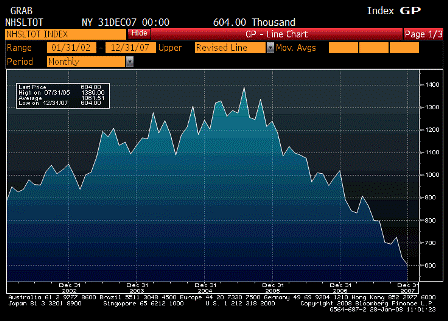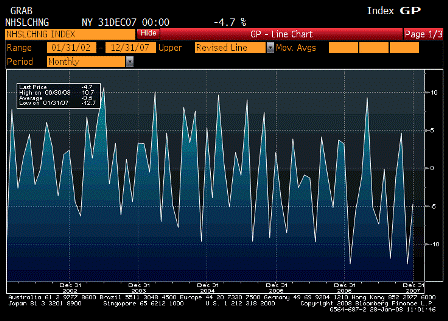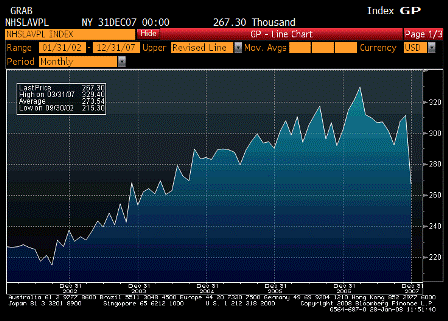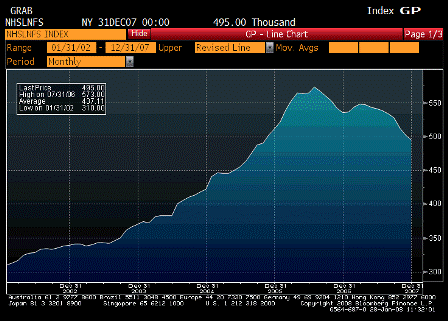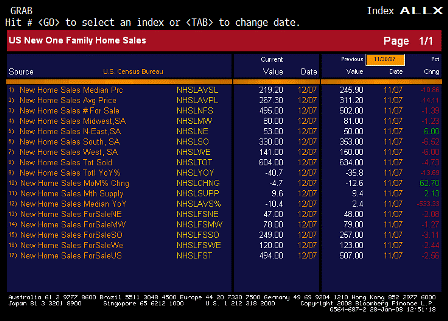The Daily Telegraph’s Ambrose Evans-Pritchard details interesting insights from Joseph Stiglitz.
No, common errors.
The United States is sliding towards a dangerous 1930s-style “liquidity trap”
Probably not – rare with floating exchange rates.
that cannot easily be stopped by drastic cuts in interest rates, Nobel economist Joseph Stiglitz has warned.
That part is true. Interest rates don’t matter much. It was the TAF that narrowed FF/LIBOR, for example, not rate cuts.
“The biggest fear is that long-term bond rates won’t come down in line with short-term rates. We’ll have the reverse of what we’ve seen in recent years, and that is what is frightening the markets,” he told the Daily Telegraph, while trudging through ice and snow in Davos.
Hardly the biggest fear.
Also, note that when the curve went negative, the media flashed recession warnings. When it went positive, they didn’t report the opposite.
“The mechanism of monetary policy is ineffective in these circumstances.
Fed and ECB research shows changes in interest rates don’t do much in any case.
I’m not saying it won’t work at all: it will help the banking system but the credit squeeze is going to go on because nobody trusts anybody else. The Fed is pushing on a string,” he said.
This is very different from the early 1930s.
The grim comments came as markets continued to suffer wild gyrations, reacting to every sign of contagion spreading to Europe, Asia, and emerging markets.
Wall Street has begun to stabilize on talk of a rescue for the embattled bond insurers, MBIA and Ambac.
Another issue that interest rates have nothing to do with.
The Fed’s 75 basis point rate cut allows the banks to replenish their balance sheet by borrowing at short-term rates and lending longer term, playing the credit ‘carry trade’,
Banks are not allowed to take that kind of interest rate risk. The regulators have strict ‘gap’ limits for banks and monitor it on a regular basis.
hence the 9pc rise in the US financials index yesterday. But confidence remains fragile.
I think that was on the monoline rumors as well as prospects for strong earnings. And they were sold down to very low levels previously.
Professor Stiglitz, former chair of the White House Council of Economic Advisers, said it takes far too long for monetary policy to work its magic. This will not gain much traction in the midst of a housing crash.
True. Not much is a very strong function of interest rates.
“People have been drawing home equity out of the houses at a rate of $700bn or $800bn a year. It’s been a huge boost to consumption, but that game is now up.
Most studies don’t show much of a wealth effect or ‘cash out’ effect. The Fed has a three cents on the dollar rule of thumb on the way up, maybe less on the way down.
House prices are going to continue falling,
Maybe.
and lower rates won’t stop that this point,” he said.
As above.
“As a Keynesian,
Keynes wrote in the context of the gold standard of the time, though it probably wasn’t his first choice of regimes.
I’d say the biggest back for the buck in terms of immediate stimulus would be unemployment assistance and tax rebates for the poor. That will feed through quickly, but set against the magnitude of the problem, even a fiscal stimulus package of $150bn is not going to be enough,” he said
Enough for what? It’s about 1% of GDP. If exports are strong, GDP may be running at 2% or more without the fiscal package.
And it will add demand when demand is already enough to drive up CPI faster than the Fed likes.
(Way less inflationary and way more beneficial to offer a job at a non disruptive wage to anyone willing and able to work to sustain full employment by ‘hiring off the bottom’ rather than simply adding to demand as planned.)
“The distress is going to be very severe. Around 2m people have lost all their savings,” he did.
How does he know that? Guessing from his projections of home prices?
NASDAQ president Bob Greifeld expressed a rare note of optimism at the World Economic Forum, predicting a swift rally as the double effects of the monetary and fiscal boost lift spirits.
“I think the stimulus package that’s been proposed by the President, to the extent that this is passed in rapid fashion by Congress, has the ability to forestall a recession,” he said.
True, and if there wasn’t going to be a recession, it will magnify the expansion and inflation.
“At the moment, our business is doing better than it ever has because the volumes have been incredibly high. So, it’s been very good for us,” he said.
No recession there.
There were scattered signs of improvement across the world today, with Germany’s IFO confidence index defying expectations with a slight rise in January. Japan’s quarterly export volume held up better than expected.
Recession is currently mostly an expectation, not a current condition.
Even so, the global downturn may already have acquired an unstoppable momentum, requiring months or even years to purge the excesses from the bubble.
Precious few signs of a real economic downturn yet. Just some possible weakening.
Professor Stiglitz blamed the whole US economic establishment for failing to regulate the housing and credit markets adequately, allowing huge imbalances to build up.
Institutional structure provided incentives for lender fraud that resulted in a lot of aggregate demand from high risk borrowers getting credit for a while.
“The Federal Reserve and the Bush Administration didn’t want to hear anything about these problems. The Fed has finally got around to closing the stable door (on subprime lending), but the after the horse has already bolted,” he said.
Whatever that means.
♥

